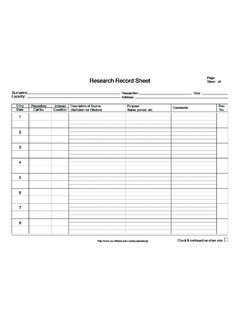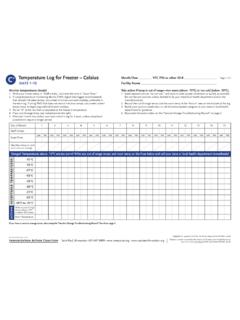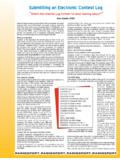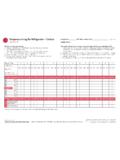Transcription of 262-2011: The Top 10 Head Scratchers: SAS® Log …
1 SAS Global Forum 2011 Programming: Foundations and Fundamentals Paper 262-2011. The Top 10 Head- scratchers : sas log Messages That Prompt a call to SAS Technical Support Kim Wilson, SAS Institute Inc., Cary, NC, USA. ABSTRACT. As a DATA step programmer, you know the sigh of relief that comes when your job finishes and your sas log is clear of any errors or warnings. When these messages do occur, most of the time they are intuitive enough so that you can move directly to the offending code, make the necessary changes, and complete the job successfully. However, what do you do about those perplexing messages that sometimes appear, making you scratch your head in puzzlement? This paper examines the top 10 errors, notes, and warnings that prompt DATA step programmers to call SAS. Technical Support. The discussion addresses the common causes of the messages and provides solutions so that you can reduce your troubleshooting time and effort.
2 INTRODUCTION. The DATA step is a powerful method for creating and manipulating SAS data sets. Customers with different backgrounds and levels of programming experience use the DATA step to reshape data, summarize data within BY. groups, and perform many other logic-related tasks. Sometimes, though, errors, notes, and warnings can occur in your sas log even if your programs seem syntactically correct. Often, the messages are intuitive and you know immediately how to fix the problem to obtain a clean log. However, in some instances, it might not be clear how to troubleshoot the message. This paper describes some of the most common log messages that have been reported to the DATA step team within the Technical Support Division of SAS. Most of these messages are formally documented in SAS notes, which are searchable on the SAS Customer Support Web site ( ). This paper groups the top 10 head- scratchers by errors, notes, and warnings.
3 Each message is described, often with code examples. Tips for avoiding the messages are also offered. Hopefully, understanding these common pitfalls can help you write code that produces clean logs more often. ERRORS. The errors that are described in this section are some of the most common errors that prompt a call to the DATA step group within Technical Support. The following scenarios provide additional information about analyzing programming issues and fixing potentially damaged data sets. ERROR: AN INTERNAL ERROR HAS OCCURRED WHILE READING A COMPRESSED FILE. PLEASE call YOUR SAS SITE REPRESENTATIVE AND REPORT THE FOLLOWING . You might encounter this error when you are reading a compressed SAS data set. This error often indicates that the compressed data set you are reading is corrupt. This error can result from a system failure that occurs while the data set is being written, from network errors, or other issues related to I/O.
4 You can attempt to repair the corrupt data set by running the DATASETS procedure with the REPAIR statement as shown in this example: proc datasets library=your_lib;. repair a;. quit;. This code might repair the damage, but not in all instances. For example, if the data set resides on a network drive, problems with the network card, cable, or driver could be the culprit. In this case, move the data set to a local drive and reference the data set in a SET statement to see whether it can be read without errors. If errors still occur, run the preceding PROC DATASETS code again. If this fails, restore the data set from your backup copy, if one exists. If one does not exist, then you need to re-create the data set. 1. SAS Global Forum 2011 Programming: Foundations and Fundamentals ERROR: ARRAY SUBSCRIPT OUT OF RANGE AT LINE N AND COLUMN N. An array is a temporary grouping of variables that are arranged in a particular order and identified by an array name.
5 Using an array can save many lines of code because one action can easily be performed on multiple variables. Variables in an array can be referenced by their variable names or by the array name (n), where n is the location of the variable in the array. When an array reference is made to a nonexistent variable, this error occurs. The following code shows how the error can occur: data b;. set a;. array test(3) x y z;. do i=1 to 3;. if test(i) > test(i+1) then newvar='yes';. end;. run;. In this sample code, the array contains three variables. The IF statement compares the current array variable to the adjacent variable. When I=3, the IF statement tries to compare Z to the fourth variable in the array, which does not exist, and an error occurs. This error message can surface in many different scenarios, but it always relates to the array variables. After the error message occurs, SAS transfers all of the variable data to the log, which helps tremendously with debugging.
6 Here is the log for the previous sample code: x=1 y=2 z=3 i=3 newvar= _ERROR_=1 _N_=1. As you begin debugging, the value for the automatic variable _N_ tells you that the error occurred during the first iteration of the DATA step. The variable I has a value of 3, so you know that there was a problem on the third instance of the DO loop. If you add these values to the IF statement, you see that a fourth variable does not exist. To resolve this error, modify your code to reference only the variables in your array. In this example, use a value of 2. as the upper boundary of the DO loop, as shown below: do i=1 to 2;. ERROR 48-59: THE FORMAT $NAME WAS NOT FOUND OR COULD NOT BE LOADED. This error occurs when you are attempting to format a character variable with a numeric format. Consider the following code: data a;. x='12345';. format x mmddyy10.;. run;. The variable X was created as a character variable but was given a numeric format.
7 The compiler assumed that you intended to use the format specified with a $ prepended to it. This results in an unknown format name. The problem is easy to correct: Just remove the quotation marks ( ' ) from the value for X, and the problem is resolved. This error can also occur if the variable type is changed by another statement in the program. Consider this example: data a;. x='12345';. y=input(x,$5.);. format y mmddyy10.;. run;. In this sample code, Y was created with the INPUT function, which is used to convert a character variable to a numeric variable. However, the informat that is specified determines whether the result is character or numeric. In this case, a numeric informat should have been supplied because it tells SAS how to read the variable that is listed as the first argument to the function. Because the informat is a character informat, the variable Y is created as a character variable.
8 The numeric format is specified for Y, which results in this error message: ERROR 48-59: The format $MMDDYY was not found or could not be loaded. 2. SAS Global Forum 2011 Programming: Foundations and Fundamentals You can also receive a similar message if you specify a user-created format and SAS is not aware of where that format is stored. If you receive a SAS data set and a format catalog containing custom formats that apply to variables therein, you must store the catalog in a location and then notify SAS of that location. You specify the location by issuing a LIBNAME statement with the reserved libref of LIBRARY. SAS knows to look in that location when a custom format name is called. You might use a different libref, but you must specify that name in the FMTSEARCH=. system option. If you fail to issue the LIBNAME statement, you receive this error message. The custom format name, in this case MYDATE, is shown in this sample sas log : data b.
9 Set a;. format x mydate.;. ------- 48. ERROR 48-59: The format MYDATE was not found or could not be loaded. run;. NOTES. Notes in the log often mean that something is not correct programmatically. You cannot always tell what code changes you need to make simply by reading the note in the log. This section presents some of the most common notes that require extra thought in order to make the necessary changes to the code. NOTE: THE MEANING OF AN IDENTIFIER AFTER A QUOTED STRING MAY CHANGE IN A. FUTURE SAS RELEASE. INSERTING WHITE SPACE BETWEEN A QUOTED STRING AND THE. SUCCEEDING IDENTIFIER IS RECOMMENDED.. Beginning in SAS 9, you might receive this note when you place an alphabetic character immediately after a closing single ( ' ) or double ( " ) quotation mark. SAS constants, which are also called literals, are number or character strings inside quotation marks and followed by a lowercase letter that indicates the type of constant.
10 For example, a character hexadecimal constant is a string of an even number of hexadecimal characters enclosed in single or double quotation marks, followed immediately by an X. (that is, '20'x is the hexadecimal representation for a space on an ASCII machine). If you want SAS to convert a constant for a specific date and time to a SAS datetime value, then you should enclose the constant in quotation marks followed by DT, as shown in the following example: '01jan2011:12:30:22'dt As a result, SAS converts this datetime value to a SAS datetime of 1609504222. This note informs the programmer that a letter was specified immediately following a closing quotation mark, but the letter is not currently a SAS literal. To remove the note, find the offending character that follows the closing quotation mark and add a space between the quotation mark and the character, as shown in this example: data a.

















